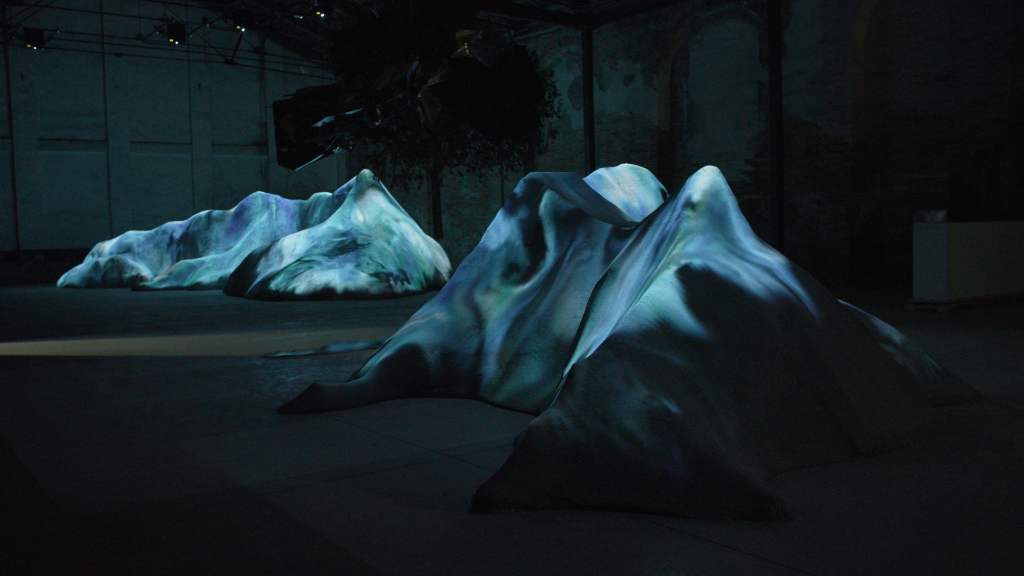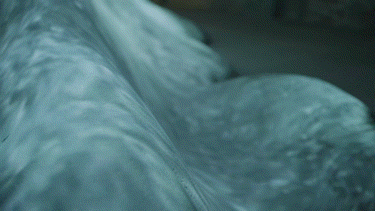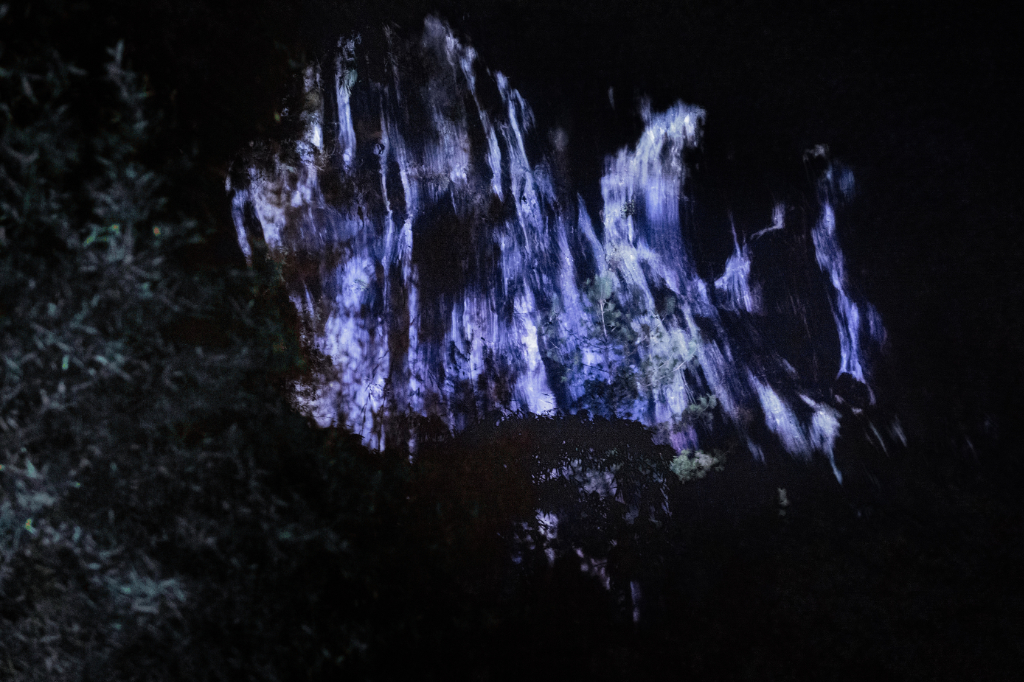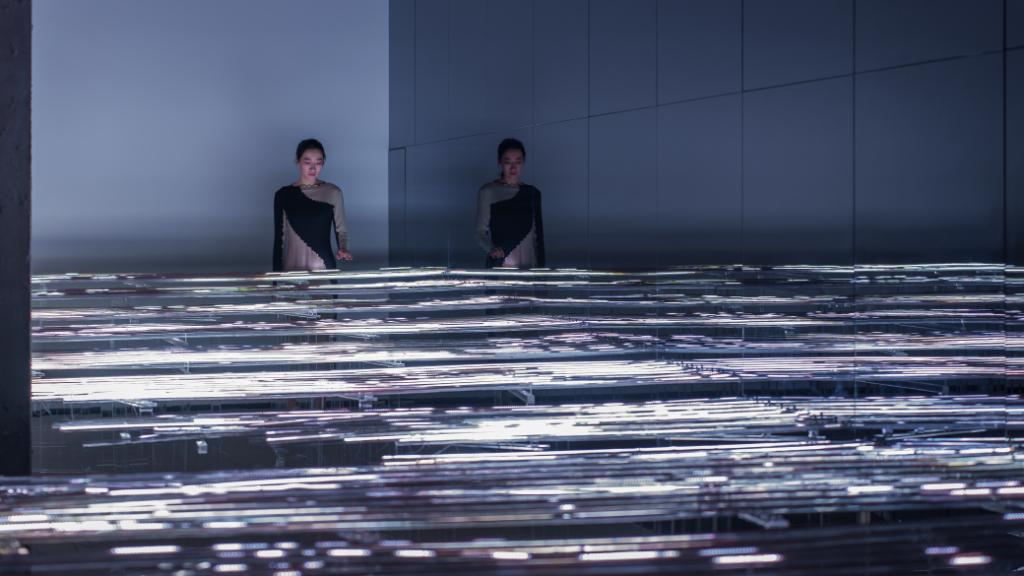Interview by Colter Ruland

The wilderness has been the subject of human fascination across epochs, taking on various connotations and responses, ranging from a ‘counter-world’ to civilisation to current efforts of preservation.
Jiayu Liu is a Beijing and London-based new media artist who studied at the Royal College of Art and has exhibited internationally. Her installations recreate and augment the natural world and redefine the wilderness, focusing on the relationship between humans, nature, and the lived environment. Often using technologies that are at the forefront of cultural conversations —artificial intelligence, augmented reality, data visualisation, projection mapping, and much more— Liu eschews literal interpretations of such technologies as well as representative depictions of the natural world, instead focusing on our emotional responses to both. By doing so, Liu’s work dismantles technology’s apparent domination of our lives.
In Streaming Stillness 虚极静笃, which was exhibited at the 59th Venice Biennale, Liu employs deep machine learning to create three-dimensional virtual spaces informed by real data of Chinese topography and traditional Chinese ink paintings. In doing so, Liu creates a virtual realm that is sensory and rooted in the real world despite its artificial output, inspired by what the artist calls: ‘the concept of Yugong, which represents the earliest geographical imagination and contemplation in China.’
In her installation, In the Flow 逆流而上, Liu turns water flow data into a visual projection that was originally mapped onto a mountainside in Guilin, China. The installation reinterprets our understanding of karst landforms formed millions of years ago from erosion, projecting such information at once to underscore the cyclical nature of time and allow for multi-dimensional interactions with viewers.
Her recent installation, Waves of Code 激流引力, was created after a discussion between the artist and ChatGPT and originally exhibited at the Cc Foundation & Art Centre in Shanghai before being adapted for the exhibition INTERREALITY in Los Angeles. In an era of mechanical reproduction, Waves of Code attempts to reshape the reflexivity of media and how human experiences are mediated through technology. In this work, Jiayu specifically references Walter Benjamin’s exploration of mass reproduction’s impact on art and how mechanical reproduction affects the authenticity and aura of artworks.
Throughout all her work, Liu regulates technology to the background as if to reclaim such authenticity and auras. Liu creates what she calls a ‘warm embrace’ usually absent from integrations and examinations of technology and ultimately taps into the same sources of fascination and trepidation we have felt across time for the wilderness and likewise encounter now with technology’s dominion in contemporary life.





For those who may not be familiar, please introduce yourself and your practice.
I am a media artist, and I focus on immersive media installations. Over a decade of practice has led me to experiment with various art forms and media, ranging from site-specific light and sculptural work to 3D projection mapping, mobile media, mixed realities, AI, and beyond. These endeavours result in evocative, sensory, and often monumental installations that bear a distinctive imprint of Chinese artistic expression, infused with the imagery of the natural environment.
My focus extends beyond mere representation, as my installations seek to transcend the confines of visual art and become emotional expressions of the environments they depict. I invite viewers to forge meaningful and profound connections with nature and the universe. I am consistently interrogating the materiality of the media and technologies employed in my creations. Technology is frequently regulated to the background, sometimes rendered nearly invisible, while accentuating narrative elements that solicit emotional responses within the spaces that are meticulously composed.
My engagement with data is another facet of my artistic exploration. I grapple with the seemingly cold and foreboding world of environmental data and statistics, rendering it tangible and relevant to our environment and ourselves. In my work, the natural world is recreated and augmented to serve as a vehicle for exploring human responses to one’s emphasised relationship with nature and the lived environment. This sensibility gives rise to soft, immersive spaces that envelop us, almost in a warm embrace, forging unexpected connections with nature and natural phenomena.
Technology and natural phenomena are central elements to your work. How did you first arrive at this intersection?
My exploration of the intersection between technology and natural phenomena stems from a deep curiosity and fascination with both realms. It all began in 2012 when I discovered the Information Experience Design program at the Royal College of Art (RCA). Intrigued by the program’s description, I felt drawn to this direction and decided to apply. Successfully obtaining an offer, I embarked on what turned out to be two remarkable and fulfilling years at RCA from 2012 to 2014.
During my studies, I immersed myself in programming, hardware, software, and the knowledge and guidance on integrating art creation. This period at RCA became the pivotal starting point for my artistic journey. Here, I began constantly absorbing invaluable skills and insights, shaping my approach to combining technology and natural phenomena in my artwork.
I seek to evoke emotional responses and create connections with the natural world by integrating technological tools and techniques within my installations. My multidisciplinary background and continued exploration in the field have allowed me to explore experiences that hopefully blur the boundary between technology and the beauty of natural phenomena.
How do you decide when a particular natural phenomenon or environment becomes the subject of a project?
I am drawn to specific sites and natural phenomena that captivate me personally and emotionally. Creating artwork deeply rooted in a particular location is fascinating, allowing the piece to intertwine with its surroundings. This connection is one of the more captivating aspects of media art.
When deciding which natural phenomenon or environment becomes the subject of my project, I consider multiple factors. Firstly, I seek topics that resonate with me or elicit a sense of awe and inspiration. These can range from the mesmerising movement of waves to the intricate patterns formed by cloud formations.
When selecting natural phenomena or environments reflecting thematic elements, my work gains a cohesive and meaningful narrative. For instance, I might choose a forest ecosystem to explore the concept of interconnectedness and harmony or focus on the rhythmic cycles of tides to explore change and renewal.
I have a strong affinity for delving deep into the essence of a place. I enjoy conducting field studies, immersing myself in the environment, and embracing its unique sights, sounds, and sensations. Through this practice, I understood a given location’s cultural and natural significance, enriching the symbols and elements in my work. But, rather than a detailed plan, I prefer to let everything happen naturally.
In one of your earlier projects, A Real Tent, you endeavour to define ‘wilderness’ as it pertains to a natural environment as well as a concept. What do you think the role of the ‘wilderness’ is now?
The concept of ‘wilderness’ is ever-evolving. In my previous project, A Real Tent, I aimed to explore and redefine ‘wilderness’ as both a physical environment and a conceptual idea. For me, wilderness encompasses more than untouched nature—it symbolises our connection to the natural world and reminds us of our interdependence with the environment.
In today’s context, the role of wilderness is increasingly vital. It provides a refuge amidst rapid urbanisation and technological progress, offering space for introspection, contemplation, and reconnecting with nature. Wilderness also serves as a wellspring of inspiration, fostering environmental awareness and advocating for preserving and conserving natural ecosystems.
Simultaneously, with each passing creation over the past decade, I’ve come to believe that the ‘wilderness’ within me may manifest as an artwork yet to be realised or as an untapped well of inspiration. I continuously explore and discover, forging a closer bond with the natural world through each creative endeavour. As I persist, I still seek that distinct and infinite ‘wilderness,’ using my artistic expression to convey its beauty and profound impact.
The wilderness signifies an untamed or uninhabited environment, which can be at odds with advancements in human technology and historical human interest in cultivating (or dominating) the environment. How does your work reconcile this difference, or is there a need for reconciliation?
My work acknowledges the dichotomy between wilderness as an untamed, uninhabited environment and human advancements in technology and cultivation. Rather than seeking strict reconciliation between these contrasting elements, I aim to explore the complex relationship between humans and the natural world.
I recognise the importance of preserving wilderness as a valuable and irreplaceable resource. At the same time, I acknowledge that human influence on the environment is inevitable and can bring both positive and negative impacts. Through my work, I strive to raise awareness of the delicate balance required to sustain and protect wilderness while embracing the advancements and achievements of human civilisation.
The key lies in fostering a harmonious coexistence between humans and the environment. This involves promoting sustainable practices, responsible land management, and mindful engagement with nature. By highlighting the intrinsic value of wilderness and advocating for its conservation, my work aims to inspire a renewed appreciation for the natural world and encourage individuals to consider their impact on it.
Ultimately, rather than seeking a complete reconciliation between wilderness and human interests, my work encourages a thoughtful and balanced approach that respects the integrity of nature while acknowledging the role of human beings within it.
You’ve mentioned that you want the technology in your installations to become ‘invisible’ to the viewer. What do you mean by that?
When I mention that I want the technology in my installations to become ‘invisible’ to the viewer, I am referring to the idea that the technology should not overshadow or distract from the artistic experience. The focus should be on the creative concept, expression, and the overall impact of the installation rather than on the technical components used to create it.
Invisible technology implies a seamless integration of technological elements within the artwork, where they serve as tools to enhance and support the artistic vision without drawing undue attention to themselves. The viewer should be able to engage with the installation or artwork without being preoccupied with how the technology works. This way, the technology becomes an enabler for artistic expression rather than a focal point.
In your light installation, Waves of Code, you strip technology down to its essential components (LED lights and lenses) to ‘evoke diverse emotional responses.’ How do you think our emotional responses are evolving in relation to technology?
In Waves of Code, technology is stripped down to its essential components of LED lights and lenses. This minimalist approach prompts viewers to reconnect with simplicity and purity, evoking nostalgia, tranquillity, and a desire for uncomplicated experiences in our complex technological world. The installation stimulates wonder, curiosity, and a sense of discovery as viewers explore the interplay of light, perception, and simulated space. It encourages reflection on the role and impact of technology, leading to emotional responses associated with contemplation, introspection, and self-reflection.
By creating an immersive experience, Waves of Code fosters engagement, absorption, and a heightened sense of presence within the artwork. Focusing on superficial elements like light and lenses generates diverse emotional responses, establishing a personal and subjective connection with the installation. Walter Benjamin’s ideas align with this approach, as he believed technology could transform art and society. Stripping away complexity in Waves of Code reflects Benjamin’s notion of focusing on the inherent qualities of the artwork, diminishing the aura of traditional art.
Overall, Waves of Code showcases how our emotional responses to technology can evolve through simplified and artistic presentations, inviting viewers to engage with their emotions and contemplate their relationship with technology.
In your installation, In the Flow, you overlap the virtual and the real by projecting water flow data onto a mountainside in Guilin, China, specifically a karst landform created by precipitation and erosion. How does this overlap affect one’s experience of time and wilderness?
The overlap of the virtual and the real in the installation In the Flow, where water flow data is projected onto a karst mountainside in Guilin, China, profoundly impacts one’s experience of time and wilderness in a number of ways. This convergence creates a sense of fluidity in how we perceive time, alternative perspectives about the natural world, and a heightened awareness of nature and the dynamic process that has shaped the landscape over millions of years.
As the artwork unfolds, it can be envisioned as a wormhole-like portal. This overlap between the virtual and the real serves as a gateway to transcend conventional reality. It connects viewers, nature, history, and technology, offering infinite possibilities for exploration and imagination. It is a wondrous and abstract realm, providing a fresh and novel perspective on the flow of time and the essence of wilderness. Through active engagement, viewers can discover deeper connections with nature.
The natural world has been a predominant subject of art throughout history. What do technological tools such as artificial intelligence (AI) and data visualisation achieve that traditional methods cannot?
Technological tools such as AI and data visualisation offer unique advantages in depicting the natural world, surpassing what traditional methods alone can achieve. It can provide enhanced realism and accuracy, immersing viewers in simulated water flow, as seen in In the Flow, or evoke a sense of stillness and tranquillity in Streaming Stillness. Through AI algorithms and data visualisation, I can analyse and visualise large datasets, uncovering hidden patterns and connections that may not be immediately apparent. This allows me to present multidimensional interpretations and engage viewers in contemplating the intricacies of nature.
Technological tools open up new avenues for innovation and experimentation. I can use AI algorithms to generate new visual representations and explore creative possibilities that challenge traditional artistic boundaries. AI-generated data, projection mapping, and immersive experiences invite viewers to experience nature in interactive and unexpected ways. These same tools can also amplify the reach and accessibility of my artistic representations of the natural world. A wider audience can engage with and appreciate these works beyond physical limitations through digital platforms and online mediums.
Ultimately, AI transforms the artistic process and drives human innovation, acting as both a companion and a challenger. Obviously, the relationship between humans and AI has its complexities. As AI continues to evolve, it presents itself as a formidable opponent. This force challenges human artists to continually refine their skills and push the boundaries of their capabilities. The interplay between human ingenuity and AI algorithms raises questions about authorship, the role of creativity, and the ever-changing dynamics between humans and machines.
Humans and AI combine ideas, perspectives, and methodologies, producing fresh and thought-provoking creations. This collaboration bridges the gap between technology and art, blending the distinct strengths of each to offer unique insights into the world around us. In this symbiotic relationship, humans and AI shape and inspire one another, contributing to an exciting artistic exploration and innovation era.
What are you working on now?
I recently released a brand new creation titled Weaving Poetry, an immersive art piece inspired by the film The Longest Day in Chang’an. This Chinese animated film has grossed over 1.8 billion yuan at the box office. I had the opportunity to collaborate with the film’s production company for this project.
In a 15-minute narrative space, it uses poetry as expressive imagery, creating an imaginative and fantastical storytelling environment between sunrise and sunset. Through a mobile immersive experience and a giant screen, the audience is transported into extended scenes from the film, immersing themselves in a visual, auditory, and emotional journey. The changing seasons at sunrise depict the life experiences of historical personage.
At the same time, the dreamlike realm of controlling cranes is presented after sunset, evoking a surging artistic atmosphere. The journey concludes with the freedom of five hundred birds soaring over the river as the sun rises once again, offering the audience inspiring reflections on liberty and the pursuit of dreams. Eastern colours and original music enhance the audience’s sensory experience and ignite their rich imagination.
By exploring the interaction between exploration and communication, the film’s narrative structure is juxtaposed with digital art visuals, enabling the audience to reinterpret and deepen the film’s cultural connotations and emotional stories, thereby bringing about a broader imaginative world.
What’s your chief enemy of creativity?
Transcendence of self.
You couldn’t live without…
Art.





